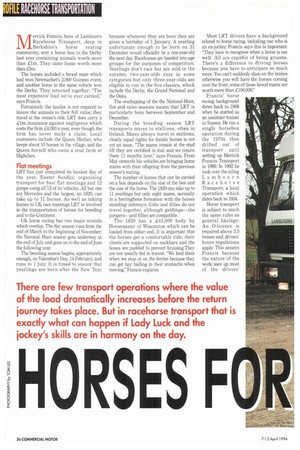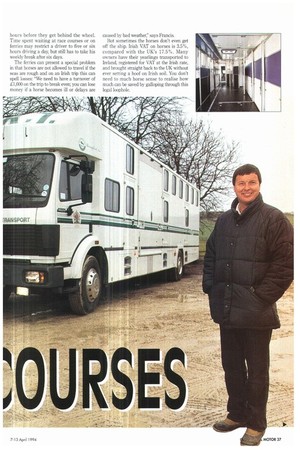M errick Francis, boss of Lambourn Racehorse Transport, deep in Berkshire's
Page 38

Page 39

If you've noticed an error in this article please click here to report it so we can fix it.
horse rearing community, sent a horse box to the Derby last year containing animals worth more than Lim. They came home worth more than £5m.
The horses included a brood mare which had won Newmarket's 2,000 Guineas event, and another horse in the same vehicle won the Derby. They returned together: The most expensive load we've ever carried," says Francis.
Fortunately the haulier is not required to insure the animals to their full value; they travel at the owner's risk. LRT does carry a Lim insurance against negligence which costs the firm £4,000 a year, even though the firm has never made a claim. Local customers include the Queen Mother, who keeps about 10 horses in the village, and the Queen herself who owns a stud farm at Highclare.
Flat meetings
LRT has just completed its busiest day of the year, Easter Sunday, organising transport for four flat meetings and 12 jumps using all 12 of its vehicles. All but one are Mercedes and the largest, an 1820, can take up to 11 horses. As well as taking horses to UK race meetings LRT is involved in the transportation of horses for breeding and to the Continent.
UK horse racing has two major strands which overlap. The flat season runs from the end of March to the beginning of November; the National Hunt season gets underway at the end of July and goes on to the end of June the following year.
The breeding season begins, appropriately enough, on Valentine's Day, 14 February and runs to 1 July. It is timed to ensure that yearlings are born after the New Year because whenever they are born they are given a birthday of 1 January. A yearling unfortunate enough to be born on 31 December would officially be a one-year-old the next day. Racehorses are banded into age groups for the purposes of competition. Yearlings don't race but are sold in the autumn; two-year-olds race in some categories but only three-year-olds are eligible to run in the five classics, which include the Derby, the Grand National and the Oaks.
The overlapping of the the National Hunt, flat and sales seasons means that LRT is particularly busy between September and December.
During the breeding season LRT transports mares to stallions, often in Ireland. Mares always travel to stallions; clearly equal rights for female horses is not yet an issue. "The mares remain at the stud till they are certified in foal and we return them 11 months later," says Francis. From May onwards his vehicles are bringing home mares with their offspring from the previous season's mating.
The number of horses that can be carried on a box depends on the size of the box and the size of the horse. The 1820 can take up to 11 yearlings but only eight mares, normally in a herringbone formation with the horses standing sideways. Colts and fillies do not travel together, although geldings—the jumpers—and fillies are compatible.
The 1820 has a £43,000 body by Horsemaster of Wincanton which can be loaded from either end. It is important that the horses get a comfortable ride; their chests are supported on neckbars and the boxes are padded to prevent bruising.They are not usually fed in transit. "We feed them when we stop or on the ferries because they can get hay balling in their stomachs when moving," Francis explains. Most LRT drivers have a background related to horse racing, including one who is an ex-Jockey. Francis says this is important: "They have to recognise when a horse is not well. All are capable of being grooms. There's a difference to driving horses because you have to anticipate so much more. You can't suddenly slam on the brakes otherwise you will have the horses coming over the front; some of those brood mares are worth more than £100,000."
Francis' horse racing background dates back to 1968 when he started as an assistant trainer in Sussex. He ran a single horsebox operation during the 1970s then drifted out of transport until setting up Merrick Francis Transport in 1989. In 1992 he took over the ailing Lambourn Racehorse Transport, a local operation which dates back to 1934.
Horse transport is subject to much the same rules as general haulage. An 0-licence is required above 3.5 tonnes and drivers' hours regulations apply. This annoys Francis because the nature of the work uses up most of the drivers' hours before they get behind the wheel. Time spent waiting at race courses or on ferries may restrict a driver to five or six hours driving a day, but still has to take his weekly break after six days.
The ferries can present a special problem in that horses are not allowed to travel if the seas are rough and on an Irish trip this can spell losses: "We need to have a turnover of 41,600 on the trip to break even; you can lose money if a horse becomes ill or delays are caused by bad weather," says Francis.
But sometimes the horses don't even get off the ship. Irish VAT on horses is 3.5%, compared with the UK's 17.5%. Many owners have their yearlings transported to Ireland, registered for VAT at the Irish rate, and brought straight back to the UK without ever setting a hoof on Irish soil. You don't need to much horse sense to realise how much can be saved by galloping through this legal loophole.


















































































